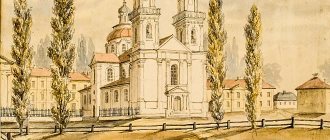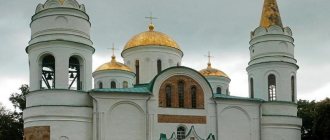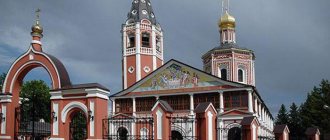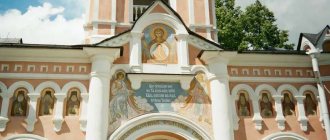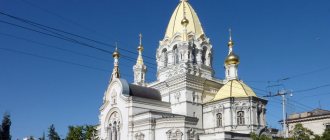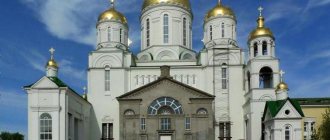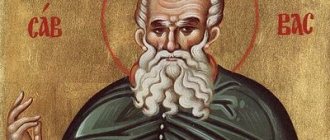History of origin
According to legend, the monastery was founded in 1030 by Yaroslav the Wise, who was given the name George in holy baptism. This is where the name of this spiritual center comes from.
The first chronicle mentions of it date back to 1119. St. George's Cathedral of the Yuryev Monastery, like all buildings, were originally wooden. But in the same year, by order of Prince Mstislav, a majestic stone temple was founded. St. George's Cathedral belongs to the creations of master Peter, who also created the Church of the Annunciation on the Settlement. This is the first ancient Russian builder whose name is mentioned in the chronicles.
Since the residence of Prince Mstislav at that time was in Kyiv, the St. George Cathedral in Novgorod was built under the supervision of his son Vsevolod and the abbot of the Kyriak monastery.
The work continued for eleven years. And before completion, its walls were completely covered with unique frescoes. On July 12, 1130, the temple was consecrated in honor of St. George the Victorious. The ceremony was conducted by Bishop John, since Abbot Kyriakos, who took charge of the construction, died two years before St. George's Cathedral of the St. George's Monastery was completed. The frescoes, the decoration of the building, were destroyed in the nineteenth century.
Great Martyr George the Victorious
Saint who lived at the turn of the 3rd–4th centuries. He was a soldier in the service of the Roman Emperor Diocletian (284–305). For his confession of faith in Christ, the pagan ruler cruelly tortured the saint and then ordered his execution. The Orthodox Church celebrates his memory on May 6 and November 16. Saint George was especially revered in Rus' as the patron saint of warriors; temples were erected in his honor and he was depicted on banners.
The image of the Great Martyr George became part of the coat of arms of the Moscow Principality, and then the coat of arms of the Russian Empire. Today Saint George is on the coat of arms of Moscow.
Structural features
Majestic in size, St. George's Cathedral in Novgorod, although inferior to the Church of St. Sofia, but is also included in the treasury of medieval architecture in Russia. The uniqueness of the temple reflects the most beautiful ideas of our ancient ancestors about harmony and beauty. After all, they were not building a structure, but, as the chroniclers write, “the image of the Church in its universal sense.”
Service schedule, operating hours
Currently, services are held in the cathedral, but the building has not been transferred to the church and is used as a museum.
Opening hours of the Historical and Architectural Museum:
- Working days : Wednesday - Sunday from 9 a.m. to 5 p.m., Monday from 9 a.m. to 4:30 p.m.,
- Days off : Tuesday.
- Sanitary days : last Friday of every month. The museum doors are open from 9 a.m. to 1:30 p.m.
From May to August inclusive, the museum is open daily from 10 a.m. to 6 p.m. There is no information on the schedule of services.
Contacts:
- Tel. (49246) 2-38-87- cash desk.
- Tel. (49246) 2-28-48 excursions.
Ticket prices:
- 20 rub. inspection of the temple inside;
- 140 rub. inspection of all exhibitions of the historical and architectural museum;
- 40 rub. cost of photo and video shooting;
Architectural solutions
St. George's Cathedral of the Yuryev Monastery has very impressive dimensions: a length of about twenty-seven meters, a width of more than eighteen and a height of exactly thirty-two meters. Its walls have mixed masonry - a combination of stone blocks and bricks. The original roof was initially made as a roof, covered with lead sheets, but later it was replaced with a hipped roof. And it is in this form that it has been preserved to this day.
St. George's Cathedral of the Yuriev Monastery is crowned with three asymmetrically located domes. The main dome is crowned with a middle cross, the second, inside of which there is a special chapel for monastic services in solitude, is located above the square staircase tower on the north-west corner, and the third - small - seems to balance the previous one.
Like other ancient Russian churches, St. George's Cathedral of the Yuryev Monastery near Novgorod was built as a large ceremonial building. On its northwestern part, master Peter placed a rectangular tower of fairly high height with an internal staircase leading to the cathedral floors. The outstanding Russian architect managed to achieve in this building amazing expressiveness of forms, brought to the limit of laconicism, as well as strictness of proportions.
How to get there by public transport
You can get to Yuryev Polsky by train, train or bus. Buses: tickets cost from 500 rubles. Travel time 3 hours 30 minutes.
| Moscow-Yuryev Polish bus station Shchelkovsky | Yuriev Polsky - Moscow Bus Station | ||
| Departure | Arrival | Departure | Arrival |
| 9.00 | 12.40 | 09.00 | 12.30 |
| 12.00 | 15.55 | 14.50 | 18.20 |
| 15.00 | 18.25 | 02.15 | 06.10 |
| 16.00 | 19.40 | 03.05 | 07.00 |
| 18.30 | 22.10 | ||
| 20.00 | 23.25 | ||
Moscow-Kineshma train departs from Yaroslavsky station, tickets cost from 500 rubles. (sedentary).
| Moscow-Yuryev Polskiy travel time 04 hours 16 minutes. | Yuriev Polsky - Moscow travel time 4 hours 56 minutes. | ||
| Departure | Arrival | Departure | Arrival |
| 22.05 | 02.21 | 01.11 | 06.07 |
Schedule of Moscow-Vladimir trains departing from Kursky Station. Ticket prices start from 531 rubles.
| Moscow-Vladimir | Vladimir-Moscow | ||
| Departure | Arrival | Departure | Arrival |
| 01.56 | 03.00 | 03.45 | 06.20 |
| 06.35 | 08.14 | 08.39 | 10.20 |
| 14.00 | 15.39 | 16.45 | 19.34 |
| 21.18 | 23.20 | 20.54 | 22.35 |
Bus Vladimir-Yuryev Polish departure and arrival bus station in Vladimir cost from 220 rubles. travel time 1 hour 20 minutes.
| Vladimir-Yuryev Polsky | Yuriev Polsky-Vladimir | ||
| Departure | Arrival | Departure | Arrival |
| 07.10 | 08.30 | 09.30 | 10.50 |
| 11.00 | 12.50 | 13.00 | 14.20 |
| 14.00 | 15.50 | 16.30 | 18.30 |
| 17.40 | 19.30 | 19.00 | 20.50 |
Bus Aleksandrov - Yuryev Polskiy Travel time 1 hour 55 minutes. Cost from 266 rub.
| Alexandrov-Yuriev Polsky | Yuriev Polsky-Alexandrov | ||
| Departure | Arrival | Departure | Arrival |
| 05.45 | 07.30 | 08.40 | 10.35 |
| 08.10 | 10.00 | 10.15 | 12.10 |
| 12.50 | 14.45 | 15.15 | 17.00 |
| 15.20 | 17.15 | 18.00 | 19.55 |
Buses from Ivanovo (Rio shopping center) to Yuryev Polsky take 3.5-4.5 hours with a transfer to Vladimir. For flights departing after 23.00, the waiting time for a transfer is 6 hours.
| Ivanovo-Yuryev Polsky | Yuryev Polsky-Ivanovo | ||
| Departure | Arrival | Departure | Arrival |
| 09.00 | 12.50 | 07.30 | 11.30 |
| 11.30 | 15.50 | 13.00 | 17.15 |
| 15.30 | 19.30 | 18.30 | 22.10 |
| 17.30 | 02.10 | 19.00 | 22.40 |
| 23.05 | 08.30 | 23.41 | 09.30 |
Due to the distance from major highways and railways, communication with the city is difficult and it is better to calculate the route there and back in advance.
Taxi phone numbers in Yuryevo Polsky:
- Leader tel.;
- Phone formula...
New solutions
Although the choirs of the cathedral are placed quite high, they do not look squeezed under the vaults. The western and eastern parts of the building are not equal in size, as, for example, in similar architectural monuments. In addition, the master, increasing the width of the small naves, which are three times larger than the thickness of the walls, made the eastern one somewhat shorter.
In the temple, it is as if there is a subconscious division into the main room intended for worshipers, and a slightly smaller one - the altar.
St. George's Cathedral is as grandiose from the outside as it is from the inside. However, there is a surprisingly equal dimensionality here, manifested in the abundance of identical windows and niches located in belts. In the precision of the composition there is a sense of a kind of academicism, almost unnoticeable due to the asymmetry of the volumetric construction and powerful stonework, not at all constrained by overly strict lines.
Interior decoration
The modern appearance of the temple is quite close to the original, exactly as it was centuries ago, and tourists who come to Novgorod see it. St. George's Cathedral of the Yuriev Monastery has an interior decoration that reflects the character and purpose of it as the main and at the same time princely church. Spacious choirs have been built here for visiting Mstislav and his son Vsevolod and their families. Here, according to Slavic custom, there are also “chambers”.
This cross-domed, three-nave and six-pillar cathedral has three altar apses. There are also two chapels in the choir: in honor of the Annunciation of the Most Pure One and the two holy passion-bearers Gleb and Boris. Unfortunately, the ancient fresco painting, for which St. George's Cathedral was famous in the Middle Ages, is almost lost to contemporaries today. Only minor fragments of the ornamental decoration of the slopes of the windows of the northwestern tower have reached us.
Information for visitors
It is recommended to combine a visit to St. George’s Cathedral with a trip along the “Golden Ring” of Russia.
Among the attractions of Yuryev Polsk it is recommended to see:
- Wooden Church of St. George, construction date 1718. This example of wooden architecture of the 18th century. made only with an axe.
- Shopping arcades on Sovetskaya Square were built at the end of the 19th century.
- Almshouse of the Meshcherins, located at st. May 1, 16. Now this is an operating clinic in the city of Yuri Polsky.
At a distance of 20 km from the city of Yuryev Polsk there is the Golitsyn family estate. The estate is located in the village. Sima. If you travel by car from St. George's Cathedral to the village, you need to leave the street. May 1 on the P-74 highway. By bus on the route Vladimir-Pereslavl Zalessky. You need to get off at the first stop from the station.
Travel time 45 min. The estate was built for Prince Boris Andreevich Golitsin. Its construction began in 1766 and was completed in 1882. Opening days are Wednesday-Friday 11.00-17.00, on Saturday the museum closes at 16.00.
Article design: Oleg Lozinsky
The role of the temple
The status enjoyed by the Yuryev Monastery in the Novgorod diocese was exceptional. Founded by leading Russian princes, for several centuries it was revered as the first in importance among local spiritual centers. At one time it was even called the Yuryev Lavra.
Since the end of the twelfth century, St. George's Cathedral has served as the final resting place not only of Russian princes, but also of the abbots of the monastery and Novgorod mayors.
In 1198, both sons of Prince Yaroslav were buried here - Rostislav and Izyaslav, who was the godson of the Monk Varlaam. In June 1233, the remains of Theodore Yaroslavich, the elder brother of Alexander Nevsky, were also brought here. Eleven years later, in May 1224, their mother, Princess Theodosia Mstislavna, also died. Several years before her death, she accepted monasticism, so in the Yuryev Monastery she was known as Euphrosyne. The princess was buried near the southern wall, next to her eldest son.
Territory
At the time of the monastery’s return to the Novgorod diocese in 1991, its territory was in a deplorable state. Several families lived here, there was a vocational school, a dormitory and workshops. Redevelopment was carried out in the buildings, making them unsuitable for the life of monks. There were no iconostases in the churches; the garden looked more like a landfill. The Spassky Cathedral stood without domes, and the entire bell tower was painted by vandals.
Homemade baked goods and organic products are sold inside. In St. Petersburg and Moscow they are made by farmers, and in Novgorod most often monasteries make them, there are definitely no chemicals there
Today the monastery is a functioning monastery and an architectural monument of Ancient Rus'. It consists of 8 main buildings:
- Cathedral of the Great Martyr George the Victorious;
- Cathedral of the Exaltation of the Holy Cross (Cathedral of the Exaltation of the Holy Cross);
- Cathedral of the Image of the Savior Not Made by Hands (Spassky Cathedral);
- Church of the Icon of the Mother of God “Burning Bush”;
- Church of St. Michael the Archangel;
- Church of St. Alexis, Metropolitan of Moscow;
- Bell tower;
- chapel-canopy over the source.
There are about 20 other buildings for various purposes on the territory: towers and fence walls, gates and buildings. Therefore, only 40% of the territory is accessible to tourists, most of it is fenced and the ordinary life of the monks goes on there
Yuriev Monastery is adjacent to the beach, so on hot days there are many people nearby who want to sunbathe or swim. This does not contribute to the solitude of the monks, but the ministers are understanding.
The monastery was built not only as a spiritual stronghold. He also performed protective functions. Its walls were first mentioned in chronicles in 1333. If you look at the monastery from above, you can see the outlines of a fortress with corner towers - churches. The two-tier walls are covered with a red tiled roof, under which there is a gallery with a series of narrow windows.
There are four buildings on the territory: Poludenny, Oryol, Northern and Archimandrite. All except the last one are cell-based, that is, related to cells.
The Archimandrite building was restored, and since 2004 it has housed the Novgorod Theological School. It is not inferior in comfort to modern secular schools: it has spacious classrooms, a library, a refectory and an assembly hall. Meetings, symposia and readings on religious issues are constantly held here. Students undergo practical training in the Spassky Cathedral, which is part of the building.
The Oryol building is occupied by the cells of monks and a hotel for pilgrims. It is located right in the fortress wall. Inside there are long curved corridors with cells that seem to have not changed at all since the 18th century. There is only a bed with a hard mattress, a chair and a table by the window. Only a dim light bulb in the corner hints at modernity.
The Midday (South) building has not been fully restored. Only the part with the Church of the Icon of the Mother of God has been repaired. The northern building is allocated for the office and cells of the governor, but restoration is still underway.
Map of the Yuryev Monastery at the entrance, there you can see where everything is
This is interesting:
The tallest building on the territory is a four-tier bell tower, built in 1838-1841. There is a reason why it seems disproportionate. According to legend, Nicholas I changed the design plan and removed the middle tier so that the structure would not exceed the Ivan the Great Bell Tower in Moscow. As a result, the height was 52 meters. Previously, a clock hung in a round niche on the upper tier. The time was struck by 17 bells associated with them. On the second level there were 15 more. The largest bell of the Burning Bush monastery weighed almost 34 tons. In the winter of 1932, all 32 bells were removed and sent for melting down.
The St. Petersburg archives contain a recording of the ringing of the Yuriev bells, recorded several days before their destruction. This bell set was the heaviest and largest in Russia.
Now the monastery has 13 bells, the largest of which is the one and a half meter “Blagovestnik”. The last restoration of the bell tower took place in 2009.
The canopy chapel above the holy spring of the Yuriev Monastery is an octagonal rotunda, supported by the surviving seven out of eight columns. It is topped with a large onion dome with a cross and kokoshniks. There is a stone bowl in the center. The date of foundation is unknown.
Before the revolution
At the beginning of the seventeenth century, the Yuryev Monastery suffered severely at the hands of Swedish invaders who occupied Veliky Novgorod. St. George's Cathedral was completely looted. But during these terrible years of captivity, as chroniclers testify, God’s providence brought about a significant phenomenon not only for Novgorod, but for all of Russia. This was the discovery of the relics of the blessed holy prince Theodore Yaroslavich. Tourists who come here on excursions must be told about this amazing event.
When in 1614 Swedish soldiers, seized by an unbridled madness to profit from something, began to dig up graves, they hoped for the discovery of treasures or at least some precious attributes of the power of local princes. They opened almost all the burials in St. George's Cathedral. In one of them, soldiers discovered the incorrupt remains of Prince Fedor. They pulled him out of the grave and placed his corpse against the wall. It was incredible that the body, not destroyed by time, remained standing as a living person.
When in the nineteenth century, the only daughter of Count Alexei Orlov-Chesmensky, Anna, who inherited her father’s enormous fortune after his death, lost interest in secular life and began to strive for a spiritual life, she spent most of her money on the restoration of St. George’s Cathedral. The archimandrite of the Yuriev Monastery at that time was Photius, who later became her spiritual father. This period became “golden” for the Novgorod monastery.
Not only St. George's Cathedral, but also other buildings were restored, and three buildings were built. A little later, a bell tower was erected.
After the revolution
During this period, which chroniclers call the Way of the Cross of the Church, St. George's Cathedral of the Yuriev Monastery also shared the fate of all other Russian monasteries. In 1922, when the seizure of church valuables began to take the form of complete plunder, not only the vestments and liturgical vessels taken from the icons were melted down, but also the silver shrine of St. Theoktista.
And only a small fraction of the valuables were sent to Russian museum collections. When the monastery was finally closed in 1929, its surviving brethren were dispersed. The devastation lasted until 1935, when during architectural restoration, for unknown reasons, its seven-tiered iconostasis was destroyed.
And when in December 1991, the St. George Cathedral of the Yuriev Monastery as part of the monastery was returned to the Novgorod diocese, it presented a very deplorable picture. The dilapidated temple, in which not a single icon remained, created a huge problem for the authorities: how to preserve and support this ancient monastery.

